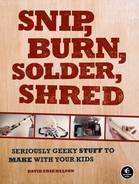Why the Pop Can Flyer works is debated by engineers, physicists, and pilots (all of whom take very different views of flight to begin with), both within their respective fields and among each other. From an engineering perspective, flight is all about boundary layer separation. The boundary layer is the thin layer of air surrounding the body of an aircraft; because air is a viscous fluid, the boundary layer tends to want to “stick” to the aircraft. In order for a body to fly, you need the boundary layer to be part of a laminar flow of air around the vehicle. A laminar flow occurs when a fluid is moving in many parallel layers in the same direction, with no disturbance between the layers. The opposite of this is a turbulent flow, where various layers of air mix in many eddies and rough, chaotic lumps. As the air flows down a body, the boundary layer (which wants to stick with the curved side of the craft) will always eventually pull away from the main laminar flow of air, creating turbulence—a process called boundary layer separation. In the worst case, a pocket of stagnant air gets trapped against the body, acting like a lump of chewing gum stuck on the side of the craft.
Whenever it happens, the boundary layer separation acts as drag on the vehicle and destabilizes the flight. The leading lip of the Pop Can Flyer (being thicker than the rest of the can but with a circumference somewhat narrower than the body of the can) creates turbulence. This mixes the boundary layer with the surrounding air as it is about to pass over the can’s length, so that the two layers more quickly form an efficient laminar flow. This more efficient flow delays boundary layer separation, so that turbulence occurs behind the can, rather than along its body. Try making a Pop Can Flyer with the full length of the can, and you’ll see that it tumbles mid-flight, as though there is a gob of chewing gum stuck to it: mid-body turbulence is basically knocking it out of the air.
